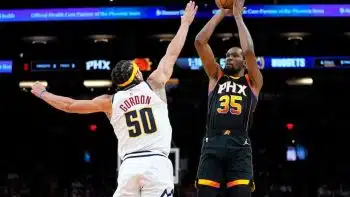NBA
NBA Daily: Has Boston’s Death Lineup Figured It Out?

The Boston Celtics were supposed to be a lot of things this season.
They were supposed to be deep. They were supposed to be dominant. They were supposed to be the favorite to come out of the east. They hype surrounding them rivaled that of the Big Three days of Kevin Garnett, Paul Pierce and Ray Allen.
Of course, there’s no need to rehash what really happened this season. However, it is time to rehash where all of that hype centered around: Their original starting lineup.
The lineup of Kyrie Irving, Jaylen Brown, Gordon Hayward, Jayson Tatum and Al Horford was projected to be a lethal starting five. They had shooting, playmaking, tight defense, etc. You name it. Most impressive among everything else was their versatility. They were believed to have no hole than any other starting five in the league could exploit.
To make a long story short: It didn’t work out. Saying that they disappointed doesn’t do that group enough justice.
They flat-out stunk.
Boston went 9-7 in its first 16 games with its supposed death lineup. In the 137 minutes that the Celtics’ original starting five played together, the group was a minus-3.9. Defensively, the group was quite adequate, allowing 94.9 points per 100 possessions. Astonishingly, a group that supposedly had so much firepower offensively only mustered up 91.1 points per 100 possessions.
This was for two primary reasons.
1. Gordon Hayward was clearly nowhere near back to normal – Something that the NBA community probably should have seen coming. He had no rhythm and was clearly physically limited. The former All-Star put up 10.1 points on 40/30/80 splits in his first 16 games. While not entirely awful, those aren’t the numbers you’d see from the likes of Gordon Hayward.
2. Jaylen Brown’s regression as a player. With the talent the Celtics had at their offensive arsenal, it was difficult for Brown to carve out his role. In the same time period, he averaged 10.9 points on 36/27/68 splits and was a team-worst minus-6.5 among players who played at least 80 minutes.
There were other reasons that played a role in the team’s struggles early on that were not as severe, like Kyrie taking a few weeks to get back to speed and Horford’s nagging knee injury. After 16 games, it was clear that Boston needed to change up the formula.
By Game 17, Hayward was relegated to a bench role, which he’d have for the rest of the season when the team was fully healthy. The same happened to Brown four games later, as the two were replaced in the starting lineup by Marcus Smart and Marcus Morris.
The group played sparingly together for the rest of the season. Hayward and Brown gradually improved as the season progressed when they were given new roles to the team. From the looks of things, Brad Stevens had moved on from the Celtics’ original starting lineup entirely. Then, Game 81 happened.
After clinching the fourth seed, the Celtics were playing a meaningless game against the Orlando Magic in its penultimate game of the season. What seemed important was making sure the team was fully healthy when the playoffs rolled around. That wasn’t the case.
Marcus Smart went down with an oblique tear, sidelining him for several weeks and thus, creating a void at the 2-spot for the Celtics. Brown was ultimately chosen to replace Smart in the starting lineup.
The Celtics are not a better team without Smart, but in his absence, it gave the team the opportunity to go back to its original starting five to see if the group could still live up to its preseason hype.
Boston has only played four games in the playoffs having swept the Indiana Pacers. In those four games, they’ve gone to that lineup in three of them, and in that time, are a plus-13.3 with the five of Irving-Brown-Hayward-Tatum-Horford, which is not only good but also a major step up from where they had been as has been previously mentioned.
It also appears to be a turn of the tide from where the positive net rating comes from. The Celtics score 123.3 points per 100 possessions with those five on the floor, making offense the group’s calling card instead of the defense like earlier.
There does seem to be a bit of confidence in that five, as the Celtics finished with that lineup in the closing minutes in two of the four games in which they faced the Pacers.
In Game 2, the Celtics put the group together in with a little less than four minutes to go to close out the game. In that time, Boston outscored Indiana 13-9 to win 99-91. In Game 3, the group was put together with five minutes and 45 seconds to go, where they again outscored the Pacers 14-9 to win 104-96.
Even if that wouldn’t fit under the label “dominant,” Boston’s death lineup has made strides since their initial disappointing output to start the season. If there’s nowhere to go but up from here with that lineup, then Boston’s chances of coming out of the East get much stronger.
A word of caution – they were playing the undermanned and offensively-challenged Indiana Pacers. Even if the series ended up in a sweep, Indiana made Boston work for its victories.
Now Boston has its toughest challenge of the season – beating the first-seeded Milwaukee Bucks four times. There’s more to this series than meets the eye. The Bucks are notably stronger since last season, and most definitely are looking for a little payback following their previous playoff series with the Celtics.
Boston is definitely going to have its hands full in the second round. If its death lineup continues to grow, maybe they will become the team that people believed they can be and its own players have said they are.










